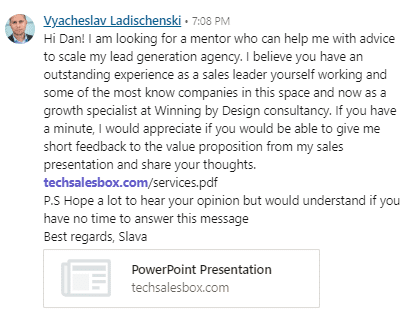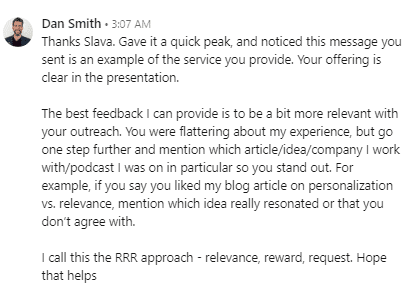
About the author
Vyacheslav Ladischenski is the founder of TechSalesBox — a lead generation agency. He holds a master degree in computer science, has previously founded 3 tech startups and worked in Germany, Switzerland, and Ireland for multinationals including Credit Suisse, PwC, Dell and IBM. At TechSalesBox Vyacheslav helps sales leaders in B2B SaaS companies to break ice with hard to reach, busy business people. The return on investment for their customers is often 10x times better than using traditional lead generation approaches as cold calling or cold emailing.
A scheduled appointment with the right target person costs SaaS companies often more than €300 because their highly paid salespeople spend on average 3 hours of time to schedule a meeting with the right target person. Without specialized knowledge, a team consisting for example of 10 salespeople spends around 7200 hours per year setting up meetings with their targets. This translates in about €540K of yearly operating costs for the company. Vyacheslav helps to reduce this cost by 10x times by offering a superior lead generation systems using LinkedIn.
How to create message templates?
Introduction
In this article, I am going to tell you the story of how one specific response on LinkedIn sustainably improved the overall success of all our Linked Helper outreach campaigns by a factor of 3x. I will then share our technique with you so you can make your LinkedIn messages more personal, effective and successful as well.
I like to ask for advice a lot because I believe you can never be wise in all areas of life. Benjamin Franklin said “Wise men don’t need advice. Fools won’t take it.” and he probably meant that wise men are confident in what they know but fools think they know more than everyone. Easier said than done, at least for me. I have to put in constant effort to stay humble and remember that I know nothing compared to what experts in my field know collectively. To put this belief into practise I have established a habit to regularly reach out to sales experts and ask for their feedback and advice.
One of the experts I contacted about 3 month ago is Dan Smith. Dan is a sales coach and trainer at Winning by Design, a SaaS sales consultancy company based in the Bay area. I had attended an event organised by Winning by Design in Dublin a year earlier but did not know Dan personally, so I sent him a LinkedIn connection request with the following message:

Dan accepted me as a connection on LinkedIn and was kind enough to look at the sales presentation we share with our clients. What I appreciated about his response was that he reflected more deeply on the actual connection message I sent him. In his short answer, he shared with me a technique called RRR (Relevance, Reward, Request) they are using with customers at Winning by Design. In the last 3 month, the RRR technique has proved to make our LinkedIn outreach campaigns 3 times more successful, personal and effective. In the following I want to explain the technique and show you some examples on how you could use it as well:

RRR (Relevance, Reward, Request)
Relevance
Your message has to be relevant for the person you connect with.
- Obviously, you want to use their first name and if possible their company name in your message. I would also recommend explaining how you found the person you are connecting with. For example:
“Hi Brian, I am looking for experts in building effective sales organizations and would like to connect…”
- In your message you can refer to a connection you have in common or, even better, to a colleague of the person you want to connect with. For example:
“I saw that we share Brian Moe as a common connection and …”
- You can quote some of the most relevant and important sentences from the persons LinkedIn summary. For example:
“I saw that you focus on helping salespeople to attain their goals through high-impact coaching and…”
- Demonstrate that you know what solutions his company offers or which clients they target. For example:
“I saw that at Gates Associates you target clients in the fintech sector and…”
- Establish connection between your passions and their passions. For example:
“I saw that you are passionate about AI technologies and…”
Reward
It is important to show the clear benefit from connecting with you.
- Demonstrate that you help people and companies similar to the person you are connecting with. You can do it by sharing your experience on the pain points your customers often have and you solve. This way the person might feel that he can benefit from connecting with you. For example:
“It takes a salesperson on average 3 hours to schedule an appointment with the right target person because they use traditional appointment setting techniques like cold calling…”
- Ask the person you are connecting with for help and show them how much they can help you. Show them that with a few invested minutes from their side, they can help you or your team to save months or years of work. People like to help you out if they feel that their efforts would be appreciated. For example:
“By having a short 10 minutes call with me, you might help us to save a year of work going in the wrong direction ..”
- Be clear on who you work with and which value proposition you are offering them. For example:
“We are helping sales leaders in B2B software companies to reduce the cost of an appointment with their target persons from over €300 to €45 or less…”
Request
You want to end your message with a clear call to action. This way you will make it easy for the person to respond to you.
- You can ask for a recommendation to a colleague or partner responsible for a particular area. For example:
“You would help me a lot if you could recommend somebody responsible for business development at Brian Associates…”
- You can offer an introduction or discovery call. For example:
“Would a 10 min call suit you on 15.05 or 17.05?”
- Finally you can end with an open question to start a conversation. For example:
“How much time or money does an appointment at Brian Associates cost you today?”
If you want to improve your LinkedIn messaging, I would be happy to give you feedback and share my advice. You can send me a particular message snippet via email or LinkedIn.